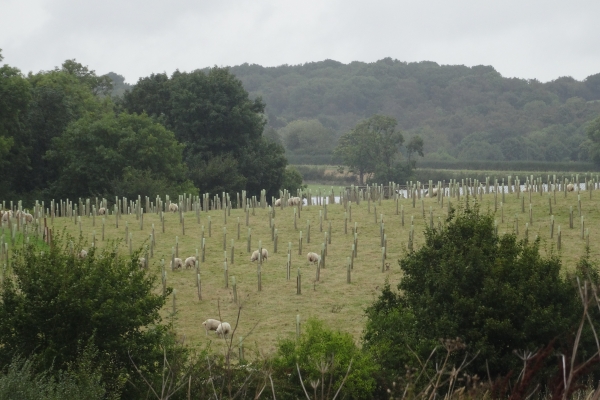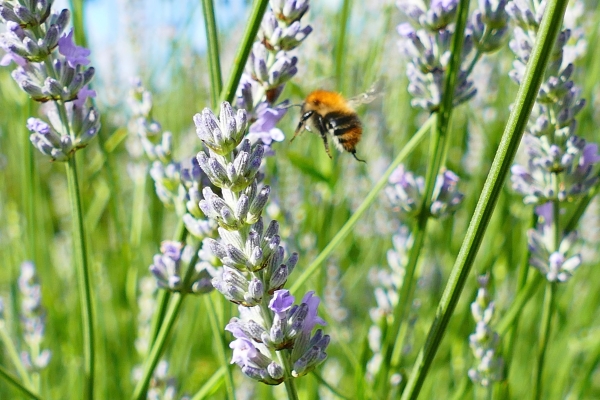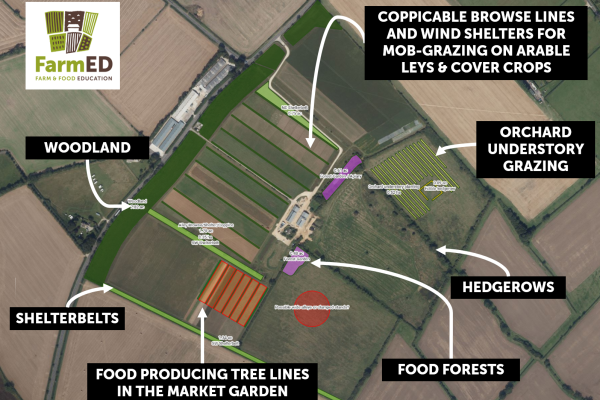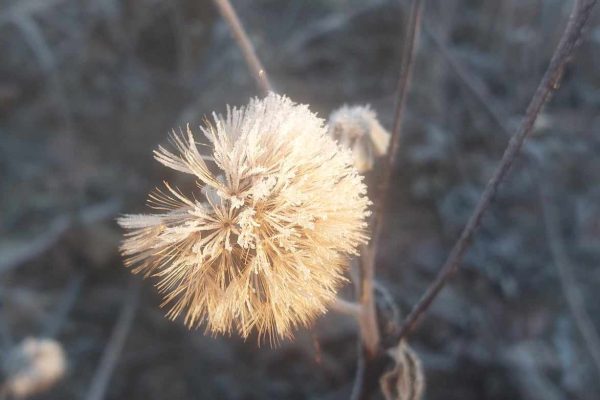Andy Dibben
Abbey Home Farm, Cirencester, Gloucestershire
*Andy and Ben Raskin have a new book out – ‘Silvohorticulture: A Grower’s Guide to Integrating Trees into Crops.’ Read a review of it here.
Abbey Home Farm is a diverse mixed, family owned 1,600 acre (ac) farm near Cirencester, Gloucestershire, that has been organic for 30 years. John Newman is farm manager for the arable, livestock and estate enterprises. I am head grower of the fruit and veg and make all the decisions within the 15-ac horticulture holding.
The farm has 300 hectares (ha) of cereals; spelt, oats, winter wheat, spring barley, triticale, whole crop silage (barley, beans and vetch), livestock; dairy cattle (35) – principally Dairy Shorthorns, beef cattle (70) – a commercial suckler herd of Aberdeen Angus Cross and Shorthorn cows bred with a Beef Shorthorn bull, 300 ewes (a closed flock of 500 Lleyn and Lleyn Cross ewes and producing lamb and breeding replacements), table birds (4 flocks of 170 birds), laying hens (350), pigs are fattened on site as well, horticulture; veg, soft fruit, flowers and herbs – 93 crop lines with an intensive market garden, field scale, glasshouse, polytunnels, orchard, and lots of cover crops.
We have a rewilding project – covering an area of 2.5 ha, and there is a lot of woodland on the farm – 4,500 m of hedgerows established since 1998 and 215 ac of mixed woodland – our main goals for which are protecting biodiversity, carbon storage and soil protection, sustainable supply of timber and woodland produce, and public enjoyment and education.
The farm shop and cafe is our primary market, selling some of everything that we produce on the farm. The shop is essentially an organic supermarket – we have to give the customers everything they can get in Waitrose – we sell citrus, avocados etc. The glasshouse was put up to ensure we can extend the season for crops, growing them out of season and securing that supply. We process our milk and all poultry onsite and use a local Soil Association-approved abattoir to process our pigs, sheep, and beef cattle. We also sell some of our milk, meats and cereal to the national organic market; beef and lamb through the Organic Livestock Marketing Co-Operative, cereals through Organic Arable (founder member), and milk through OMSCo (founder member).

My approach for producing organic fruit and veg is a systems approach, so I don’t look at irrigation, pest control, planting and weeding separately… the system is set up as one whole organic system and trees are integral to this (see ‘Silvohorticulture – a systems approach’). Strips of wildflowers are planted throughout the cropping areas to provide habitat for pollinating and predatory insects, we also have permanent untilled grassy strips throughout the cropping areas to provide habitat for beetles that are our primary defence against slugs.
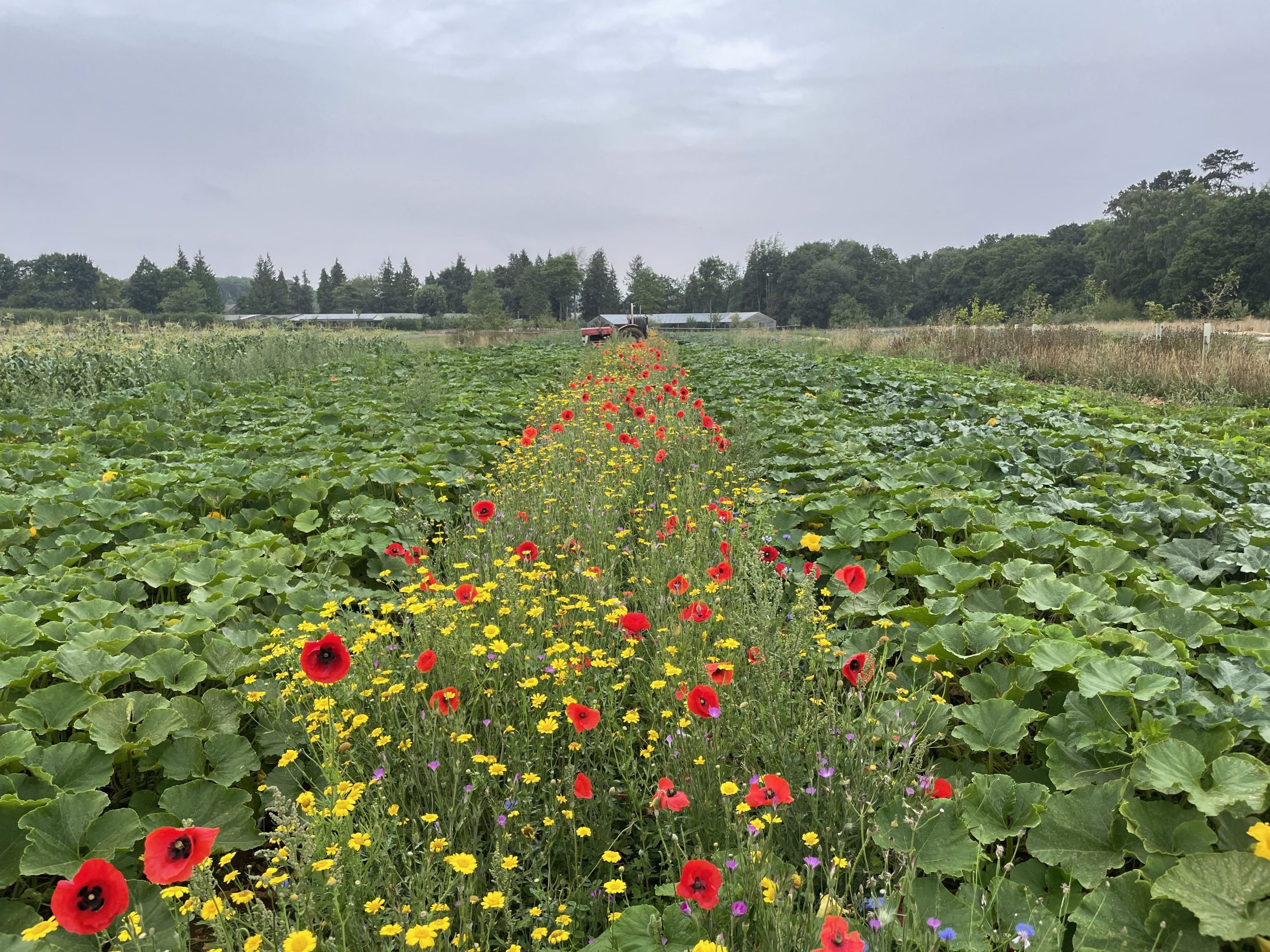
We manage our fertility and feed our healthy soils with green manures which also provide year-round habitat and food for small mammals, invertebrates and bird life. Diversity and polyculture are two approaches applied across all cropping areas; the more plants in an area, both for cropping but also for habitat and soil health, the happier we are.
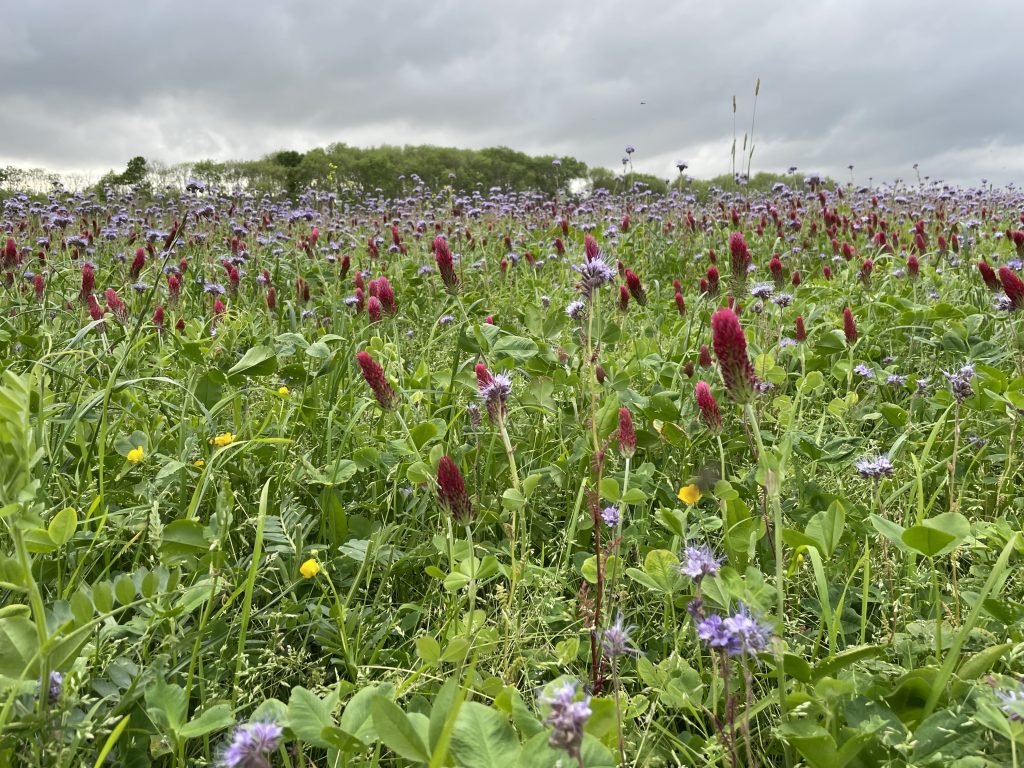
Strip tillage with a living mulch understorey
As our knowledge on soil health and botany develops, it becomes clearer and clearer that few if any plants prefer growing in isolation as a monocrop. All life interacts with each other and if managed correctly allows for a beneficial symbiosis to occur. From this starting point I have become increasingly interested in the trials happening around the world into strip tillage, especially those that involve strip tilling an established green manure and then drilling seed or planting young plants in tilled strips between the green manure. The potential of this technique is not to be understated. Currently whole fields are often ploughed or sprayed off with herbicides to prepare a field before planting. Both these techniques can lead to problems. If the strip tilling technique can be refined, it would lead to half the field being cultivated, leading to much better soil health, less erosion, boosting biodiversity, reducing labour time, diesel costs, and emissions associated with tillage.
For many years I have been a keen user and promoter of green manures for many reasons, however it has always bothered me that I often cultivate a green manure to then establish a cash crop and then undersow again with another green manure. The concept of having a green manure that stays down for a full rotation and has cash crops accurately planted into permanent tilled strips is a very attractive one, it even potentially offers the opportunity to cash crop the system every year with no need to rest fields for fertility building phases. Something we do a lot of at the moment.
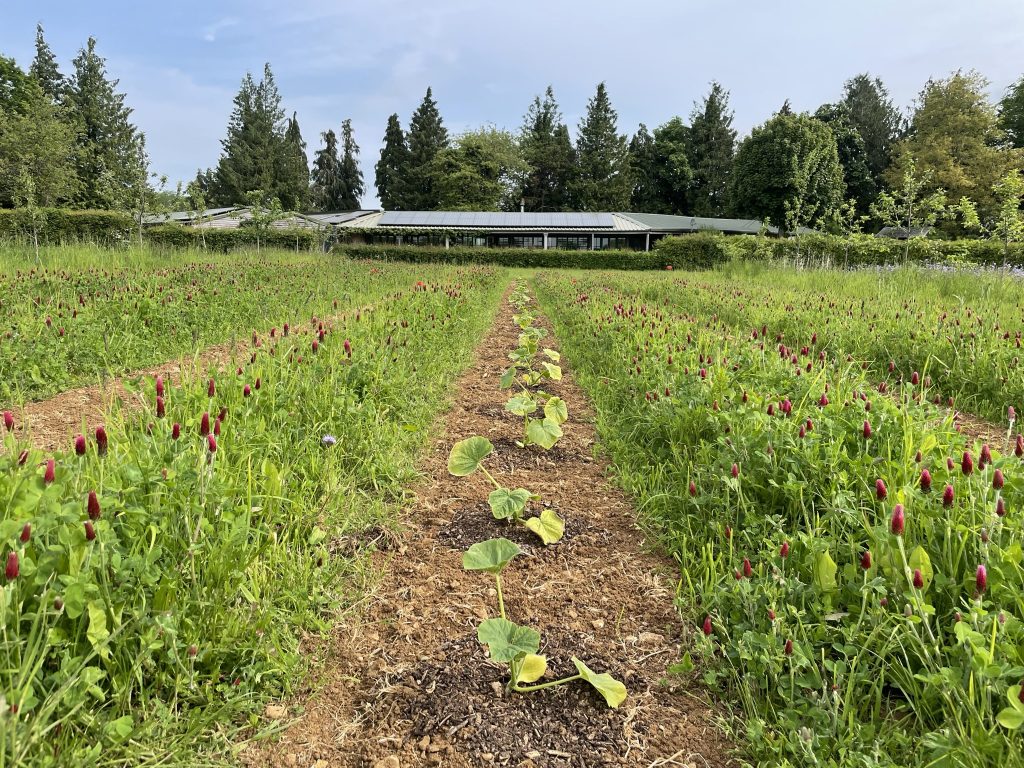
We are involved in field lab trials organised by ‘Innovative Farmers’.
We have so far trialled this technique on a number of different crops with mixed results. We have successfully cropped strawberries, broad beans, runner beans and french beans using this technique, but have struggled with courgettes, calabrese, pumpkins and leaf beets.
There are a number of variables to manage in a system like this.
- Initial preparation of strips – Choice of equipment, timing of operation and width of strip all need careful consideration. We are using a power harrow on a two wheel tractor, with the outside tines on each side taken off, giving us a tilled strip 40 cm wide. We are currently establishing strips the autumn before spring planting.
- Living mulch understorey – What and when to sow are the key considerations here. When we undersow cash crops after planting, we have historically used a yellow trefoil and white clover mix, although more recently we have started to experiment with other more diverse mixes. The challenge of using clover-based mixes is that they do not offer the longevity required to go through a five-year rotation without letting weeds take over. With this in mind, we are trialling two different mixes; one is the traditional yellow trefoil and white clover mix, the other is a very diverse mix of clovers, grasses, herbs and wild flowers. The hope is the second mix will work and last effectively for a five-year rotation. Living mulches are established the year before cropping.
- Management of strips – Strips are established the autumn before planting. They are then tilled as early in the new season as possible, then tilled again just before planting. Strips are weeded at the moment with hand hoes, but this could easily be done on a field scale with combination of modified steerage hoes and / or discs. Strips are then tilled immediately after crop removal and then once more before winter. The idea is to constantly keep strips clear from weeds and living mulch ingression, although long season crops like brassicas may benefit from strips being colonised by living mulch over winter.
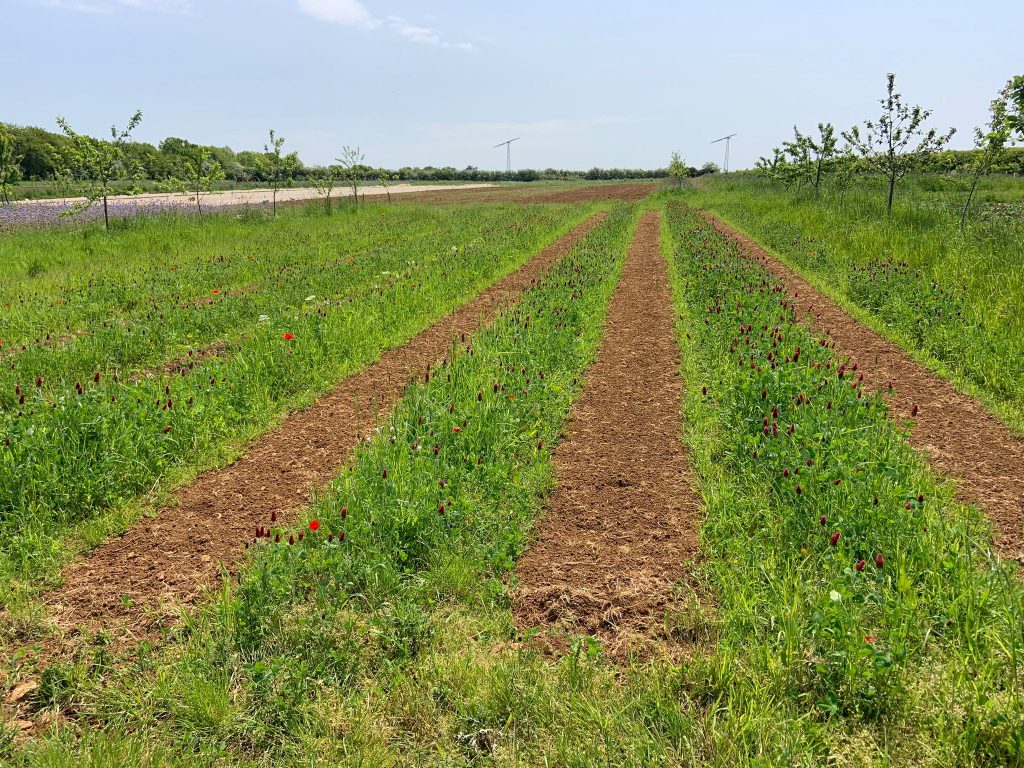
- Managing living mulch – When no cash crop is in the ground, the living mulch is managed just like any other living mulch, regularly cut just after flowering. Just prior to planting, the living mulch is cut very short in order to allow the cash crop to establish in full sunshine. This is very important in order to manage ‘shade avoidance response’ in the cash crop, which can lead to leggy unproductive crops. The aim is to establish the cash crop as the dominant plant in the area, and this involves regular mowing of the living mulch for the first 8 weeks at least. This inter crop mowing is currently carried out with pedestrian mowers as we are only trialling on a market garden scale. At a field scale in vegetable production, specialist machinery will need to be developed, modified, or built to carry out inter row mowing.
- Current challenges experienced – There seems to be an issue with early availability of nitrogen (N) to the cash crop. We have hypothesised that this may have been caused by initial tilling of strips too soon before planting the cash crop, leading to N lock up in the soil as carbon-heavy grasses are being decomposed by soil life. To offset this effect, we have switched initial tilling to the autumn before, and have replaced vigorous grasses like cocksfoot with less vigorous grasses like sheeps fescue. We are also applying some organic composted chicken manure at planting for an initial N hit to help with establishment. We have also adopted a stricter cutting regime on the living mulches, keeping them shorter for longer, and cutting at quicker intervals, to aid light levels around the cash crop.
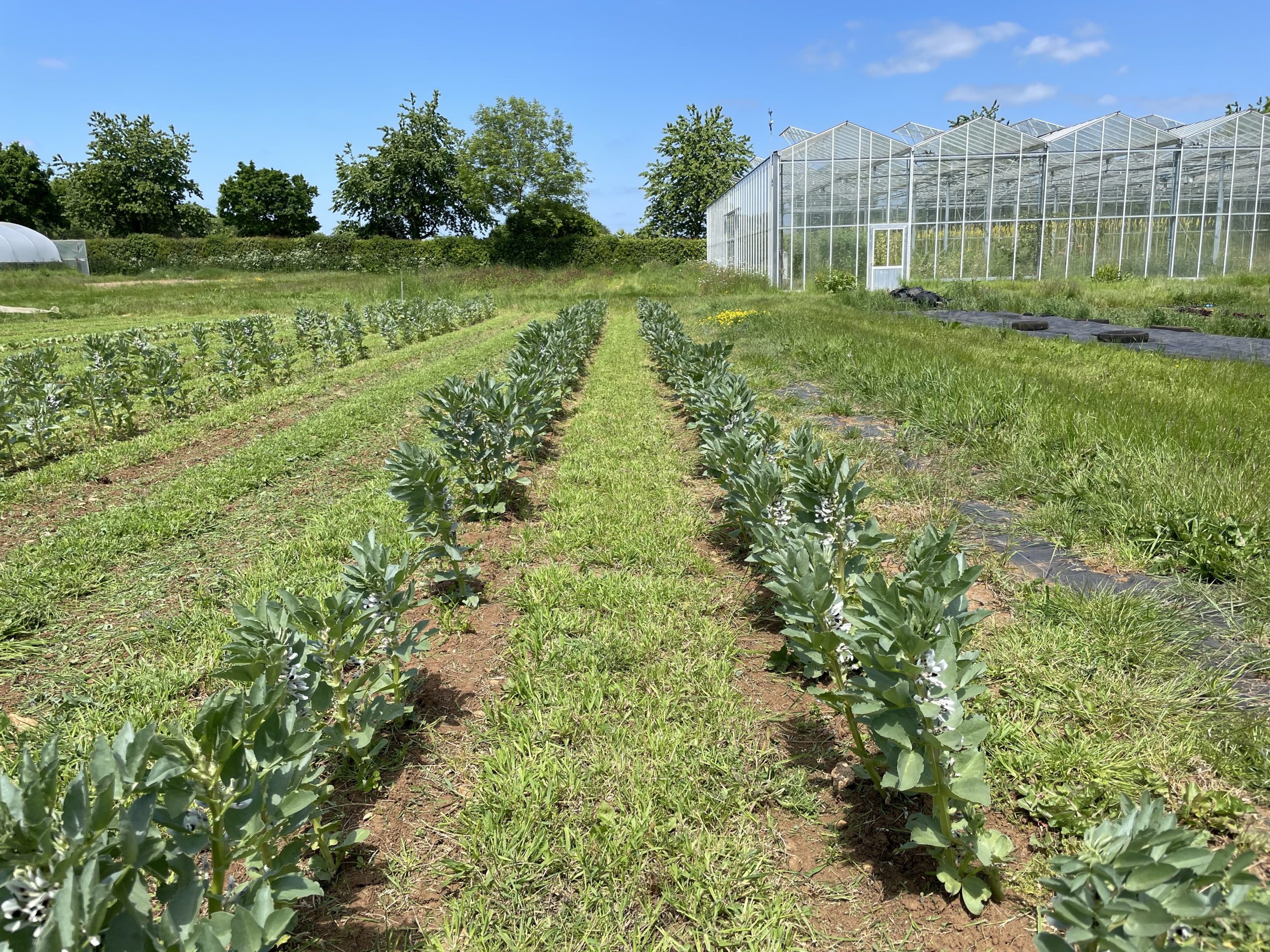
Silvohorticulture – a systems approach
A third of my production area is under agroforestry. We have a 5-ac field which I established 6 years ago.
I put in the agroforestry for all the horticultural benefits to my crops i.e. wind protection, predator habitat, creating microclimates, increasing three-dimensional cropping, reducing inputs… So the trees are part of my whole system approach to horticultural veg production.
The benefit of having other crops from my trees was secondary. With a lot of agroforestry, the crop from the trees tends to be the driving decision and then there are secondary benefits. For me, it has been very much the other way round. The veg system is designed around the trees being in it and the trees are fitted around the irrigation system, the size of the cropping areas and the rotation areas, and around our crop protection and weeding practices. All the trees are under-planted with wildflower strips – their main purpose is for attracting predatory and pollinating insects, we don’t harvest any of the wildflowers.
We are a big very old farm, so there were already a lot of trees and planned forestry on the farm. We already produced woodchip for the biomass boiler that runs the farm shop and cafe for hot water and timber for new buildings, and we already had a managed sustainable firewood setup… So we didn’t really need any of the classic timber products. With it being a systems approach, the thought process behind our decisions were we looked at what, within our existing horticultural operation supplying the shop and the café, we could bring in-house that we had been buying in… The two obvious areas were compost propagation material and we had also been buying in a lot of UK top fruit.
Once we decided we wanted some trees in the system, it was then a case of deciding on timber, biomass, or cropping trees like nuts and fruit… I don’t see it as some charitable thing, I see it as making my production far more competitive, producing inputs, so a serious tool for my horticultural production.
System layout & species
We now have intercrops of apples and coppice (hazel, willow and alder) – which will be made into woodchip which will be spread directly onto cover crops (ramial woodchip) but will also be made into compost for propagation, and we have top fruit – apples, pears, plums. We also have biodiversity species – elder, spindle and wild cherry.
There have been mainly three governing factors in the layout:
- Mathematical – to match existing equipment like irrigation and crop meshes
- Ecological – to provide predatory insect cover over the whole of the cropping area
- Wind protection – to give us full wind protection over each cropping area, we took the height of the intended trees into account. The tree height has to be 10 times higher than the width of the cropping area to make an effective windbreak.

.
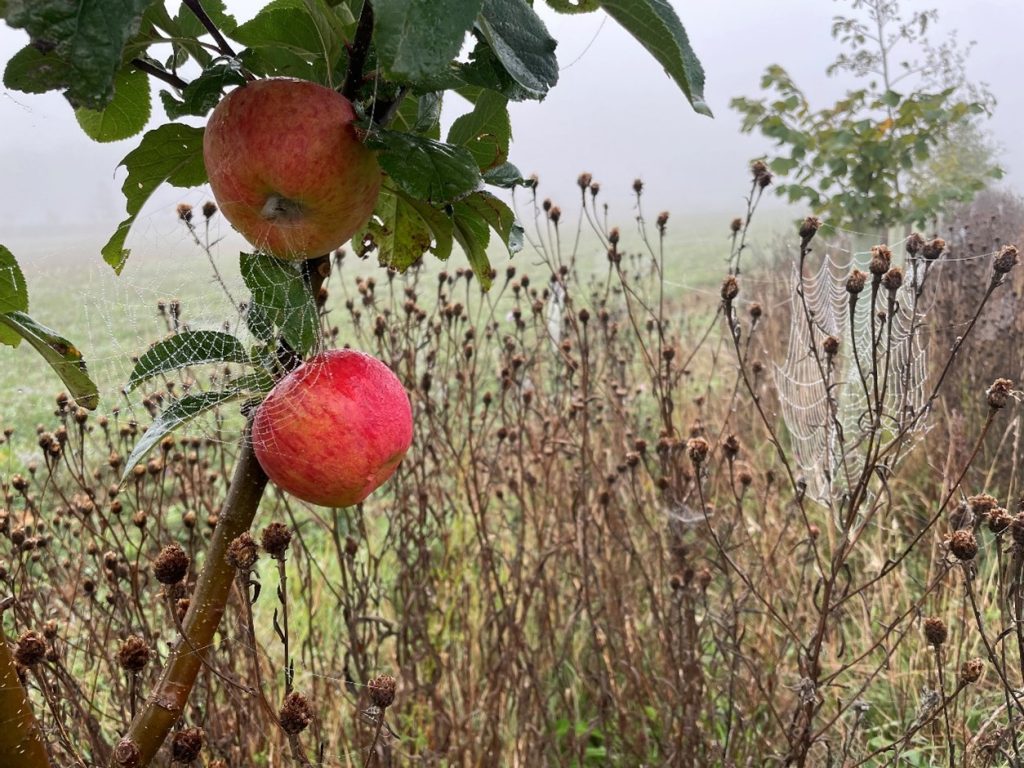
The lines of trees are 50 m apart and 100 m long. The 50 m apart is basically 3 times the width of our irrigation boom and is also perfectly divisible by the width of our crop protection meshes. 100 m is also the length of all of our existing crop protection meshes, so everything is mathematically based around existing equipment. From an ecology point of view, 50 m is the maximum productive range of beneficial insects from a permanent habitat – so by having the strips of trees and wildflowers 50 m apart, that gave us more than enough full coverage of insects over the whole of each rotational cropping area.
Management
We probably devote about 60 hours a year labour to agroforestry. The main management requirements are related to establishment, maintenance and production. January and February are very much ‘tree time’ – mulching and pruning… One thing I’m doing right now (mid July) in this hot weather is running an irrigation boom down the youngest trees I’ve got and the fruit trees with fruit on them. This year, we have had rain often enough for it not to be too much of an issue for trees, but the first 2 years after we planted, we had proper April droughts which I think are going to become more and more of an issue. A lot of people will look at planting trees February and March time when it is pouring with rain, but then will be hit by these very early droughts. We are lucky, we were set up for irrigation because we are a horticultural business, but if you were planting out across a 1,000 acre arable field, it could be a big challenge. With the climate getting hotter and droughts coming earlier in the year, it’s important to remember trees can be affected hugely.
Deciding on what, where and how to plant
I learnt the most from talking to other farmers (particularly Tolly and Ben Raskin) – speaking to people who have done it already and learning from their mistakes is probably the best way. I did deliberately sit a couple of years behind Tolly and Ben’s plantings and just watched and learned from their mistakes – positives and negatives! In silvohorticulture there was not much to copy in this country. There was a bit that had been done at Wakelyns around potatoes etc. (Wakelyns has been a massive trail blazer), but the main country I was getting information from was France. What’s fascinating is how much more information is now ‘out there’ than there was 5 years ago.
With the top fruit trees – apples, pears and plums, we picked two experts in the field. One was based at an organic fruit tree nursery in Evesham called Walcot Nursery – he’s a genius on organic apple tree production so from a variety and planting perspective we referred to him. We already has an existing relationship so got him round for a bit of consultancy (this was purely in relation to local apple tree knowledge). Then, because we are commercial and wanted to grow competitive yields in an organic system (which is tricky with top fruit), we also visited a successful established organic top fruit business in Hereford and spent the day there speaking to them about best varieties and best succession for a full season of apples i.e. August all the way through to March (with storage). They weren’t doing agroforestry but they knew their apples and pears! Particularly in an organic system you have to be very careful about your variety selection in relation to resistance etc., and also the successional need for continuous supply – because we’re a farm shop, it is not about doing one massive crop of apples and selling it, it’s about spreading out that production full season. The storage varieties are a bit of an art form.

I used to be a coppice worker before I was a farmer, so could apply my knowledge of alders, willows and hazels for coppice from my previous career, and for the wildlife trees, I used to do quite alot of woodland management for conservation… but I also looked at the trees we had on the farm that grew well and were obviously a really good habitat for birds, insects etc.
Outputs & benefits – environmental, ecological, economic…
The primary purpose has been to bring horticultural benefits but also very much to offset the challenges of climate change – winds, heavy rain and drought are the big three. The impact of trees on wind was the number one reason I became interested in agroforestry. All climate change forecasts show that weather will get more extreme – trees essentially offer mitigation against climate change. The tree lines will bring great wind protection, alleviating wind speeds across my cropping area. Reducing wind speeds mean I will get less evaporation of water in the cropping area which means I don’t need to irrigate so much. Their roots allow extreme rain events to percolate through the soil quicker, and soak up the water quicker after a big summer rainstorm.
We planted wildflowers the year before we put in the alley cropping, so planted the trees into the flower strips, and always think of that as being a part of the system. 4 years in, the biggest benefit is biodiversity – I can see the wildflower strips underneath are absolutely heaving in predatory insects. Although 2021 was quite a bad aphid year in the veg world, there were swarms of hoverflies everywhere – giving us a massive competitive advantage. Yes, I’d given up a wide strip of my cropping area, but that was far outweighed by increasing sustainable yield – I deem it as making me much more competitive and effective as a veg grower.
The pandemic has shown how important short supply chains are, so being more self-sufficient in cropping will also make me more resilient in extreme economic events.
We have a very well established and diverse education setup on the farm. We have a preschool nursery and primary school kids come down from London and stay on the farm for a week – some have never been to the countryside before. They learn about the countryside, and the trees fit into that, so there is the educational benefits of trees in the landscape that we can bring into the education side – this is probably the most important benefit of all – it’s the future!
Lessons learned
The wildflower strips can be an area where creeping thistle and couch grass can creep out from into the field. We manage this by leaving a blank strip either side which we cultivate.

It’s really important to take your time. We were lucky, we got delayed in the Woodland Trust grant application so we should have started a year earlier than we did, but that year’s delay turned what was essentially for me three or four months of intense learning and priming into a year and three months, and I pretty much changed everything! So it is really important to allow a proper amount of time to think things through. Although it is all the rage at the moment, proper planning and preparation is vital. Trees can be in the ground for hundreds of years so you really have to put them in the right place.
There is too much emphasis on number of trees in the ground and not enough on aftercare. I am very lucky, I have water everywhere so can water my trees, but with serious droughts it is becoming a bigger and bigger challenge.
Costs
Costs incurred have been for planting and we had to re-orientate a field. We had to take the field out and put it back into production, so there have been ongoing labour maintenance costs. We got funding from the Woodland Trust via the PUR project (now called ‘Trees for your farm’ – find out more and register an enquiry here). The Woodland Trust grant covered the cost of trees and protection. All the labour and mulching costs since have come out of the farm pocket. Because we’re a veg farm we were already set up with rabbit fencing, but if you’re an arable or pasture farmer, you probably won’t be, and that cost of protection from both wildlife and livestock can spiral out of control.
Agroforestry in protected cropping
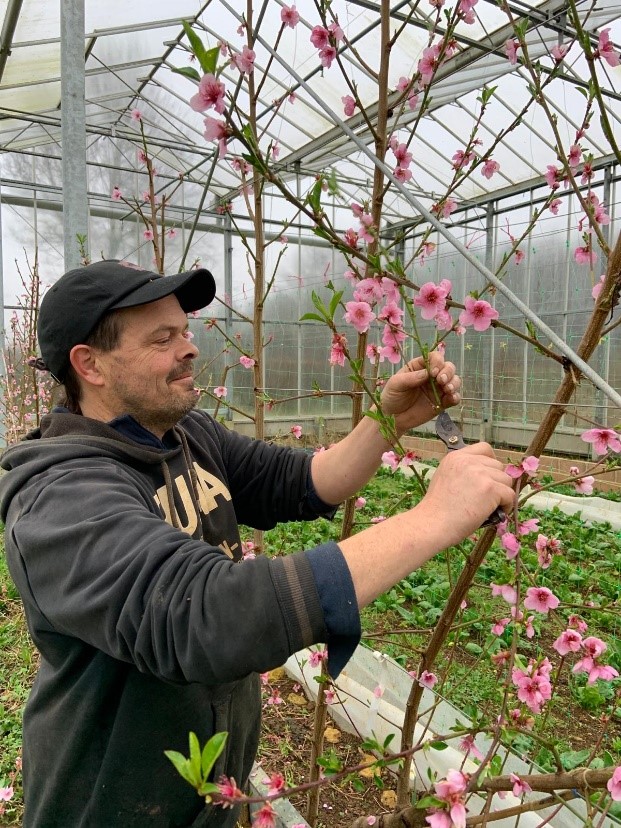
We have expanded silvohorticulture across further areas of our cropping and have established fan-trained peaches in our glasshouse, separating rotation areas and making good use of areas around the structure where growing annual veg is difficult.
Most people with a big glasshouse put in really expensive shading systems – we want to try and do the same with plants. When we need light in the winter, none of the peaches or climbers will have leaves so we will get maximum light on the crops. In the summer, when it’s too hot and sunny in the glasshouse, if we had peaches in there out in full leaf, they would be casting shade on the ground and cooling the glasshouse, and improving our crop production around them.
Future plans
We are currently looking to redesign our market garden to integrate trees into the vegetable cropping further.
Wider scale adoption of agroforestry
Help towards establishment and maintenance costs would encourage more farmers to adopt agroforestry. We got a grant straight away, it was quite quick to do. Start-up costs without a grant though would be a big stumbling block, for a farmer to put in trees now, there needs to be an upfront incentive. With what I planted, apple trees will be in production within 10 years, and we’ll probably be getting good amounts of coppice within 20, but then with a lot of other areas of agroforestry ie. nut production, it can take a good many more years… so many farmers wouldn’t be planting those crops for their own income. If you’re talking timber, that’s for your great grandchild. The start up costs are really important to skip over that generational gap – where there may be no advantage to the current tenant in key timber crops.
Farm-by-farm, everyone always has different reasons for doing things, but on a country wide approach, climate change mitigation is the really important one.
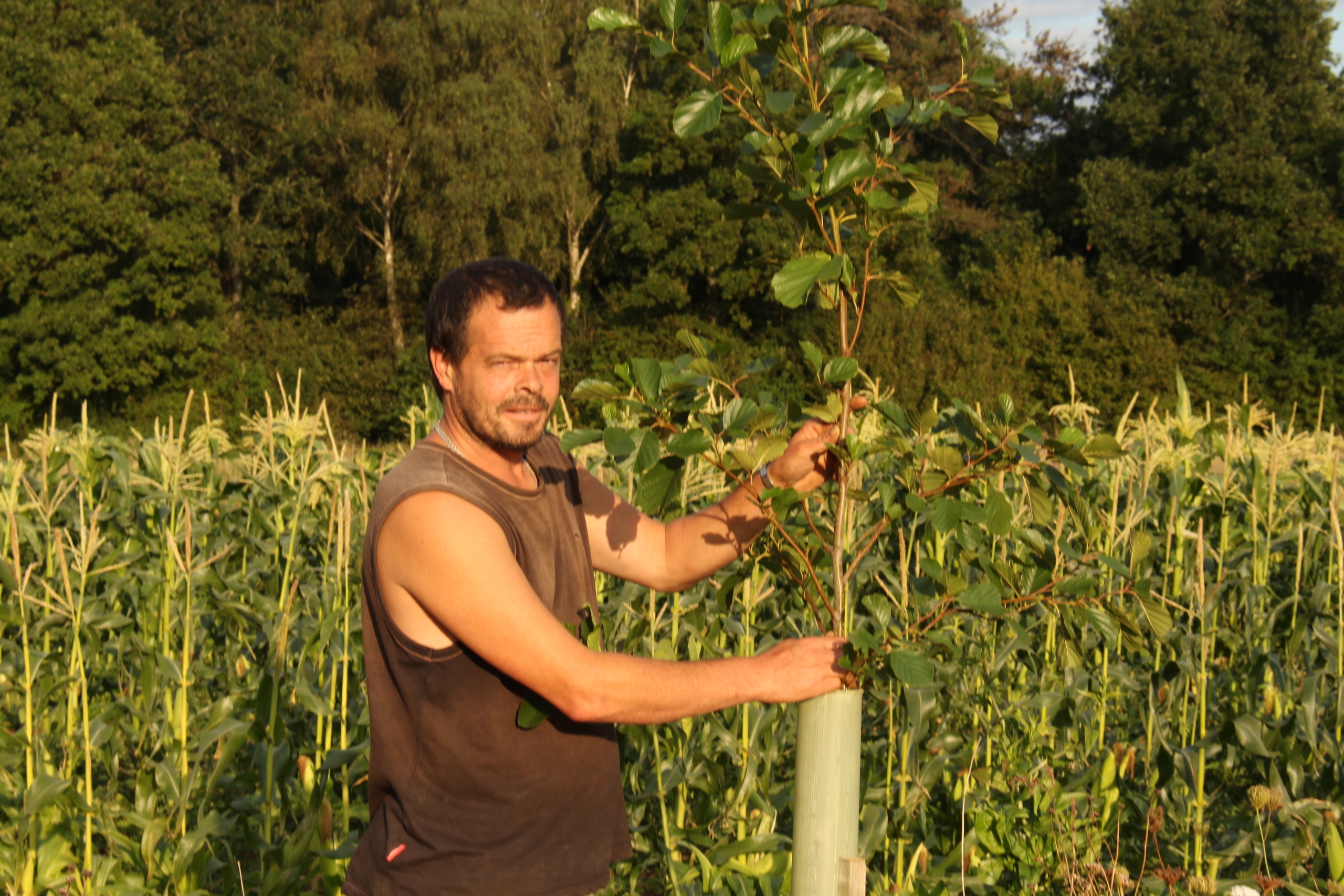
Andy Dibben’s farmer tips
- Planting and maintaining 50 trees really well for the first 3 years is much better than planting 1000 and forgetting about them. Make sure you put the emphasis on aftercare.
- Access to water will be an increasing challenge for trees in times of drought – you need to consider carefully where and what you plant in relation to this.
- Don’t skimp on the mulch on your trees however tempting – if you’re planting thousands of trees you’re going to go through a lot of mulch, but the more mulch you get down the faster the trees get away, so don’t skimp.
- Do as much research as possible – there is so much information out there, read everything!
- Prime your understorey before you plant your trees. We have had 3 different years of planting, but the years where we established the wildflower strips in the autumn and then planted them up in the spring with trees worked really well. Trying to establish plants around the trees is a lot harder than doing it before you put them in.
Andy is featured in the first of the Organic Grower Podcast where he talks (extensively!) about year-round crop production, growing in 1000 sq m of glasshouse, cover crops, issues of scale, and gives some top tips for growing parsnips and cauliflowers. Listen to it here.
Andy is part of the ‘Strip-till in horticulture : cover crops and living mulches’ Innovative Farmers field lab in which four organic vegetable producers are investigating the benefits of a strip tillage system in organic and low-input/regenerative horticulture, comparing different cover crops and living mulches They are exploring different management techniques as part of a strip till system, and comparing them to their previous practices in terms of inputs, yield and soil health. Andy features in several short videos documenting this, see below…
Andy is also part of a group of growers sharing knowledge and experience of increasing diversity in protected cropping as part of the DiverIMPACTS project. In 2021 the group tried out Caliente Mustard as a biofumigant and looked to increase wildflowers in the polytunnels to attract beneficial insects.
This profile was originally created by Janie Caldbeck as part of A National Network of Agroforestry Farms project. Find out about it here. It has since been updated mainly to include strip tillage and living mulch trials and reflections, and information on agroforestry in protected cropping. With very many thanks to Andy Dibben.
All photos and video footage courtesy of Andy Dibben. All Rights Reserved

